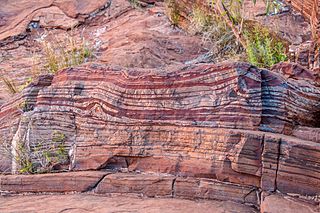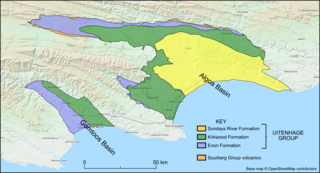Related Research Articles

Paraceratherium is an extinct genus of hornless rhinocerotoids belonging to the family Paraceratheriidae. It is one of the largest terrestrial mammals that has existed and lived from the early to late Oligocene epoch. The first fossils were discovered in what is now Pakistan, and remains have been found across Eurasia between China and the Balkans. Paraceratherium means "near the hornless beast", in reference to Aceratherium, the genus in which the type species P. bugtiense was originally placed.

The Siderian Period is the first geologic period in the Paleoproterozoic Era and lasted from 2500 Ma to 2300 Ma. Instead of being based on stratigraphy, these dates are defined chronometrically.
In the Dove Book and Russian folklore, the Indrik-Beast is a fabulous beast, the king of all animals, who lives on a mountain known as "The Holy Mountain" where no other foot may tread. When it stirs, the Earth trembles. The word "Indrik" is a distorted version of the Russian word edinorog (unicorn). The Indrik is described as a gigantic bull with legs of a deer, the head of a horse and an enormous horn in its snout, making it vaguely similar to a rhinoceros. The Russian folkloric creature gives its name to a synonym of Paraceratherium, Indricotherium, the biggest land mammal ever to live.

Fulgurotherium is a dubious genus of ornithischian dinosaur from the Late Cretaceous (Cenomanian) Griman Creek Formation. It lived in what is now Australia.

Tienshanosaurus is an extinct genus of dinosaur from the Late Jurassic. It was a sauropod which lived in what is now China. Only one species is known, Tienshanosaurus chitaiensis, which was named and described in 1937.

Tehuelchesaurus is a genus of dinosaur. It is named in honor of the Tehuelche people, native to the Argentinian province of Chubut, where it was first found.

Dvinia is an extinct genus of cynodonts found in the Salarevo Formation of Sokolki on the Northern Dvina River near Kotlas in Arkhangelsk Oblast, Russia. It is the only known member of the family Dviniidae. Its fossil remains date from the Late Permian and were found with Inostrancevia, Scutosaurus and Vivaxosaurus.

NGC 4194, the Medusa merger, is a pair of interacting galaxies in the constellation Ursa Major.

Batrachosuchus is a genus of temnospondyl that existed from the Early to Middle Triassic of southern Africa and the Blina Shale of Australia.

The Kirkwood Formation is a geological formation found in the Eastern and Western Cape provinces in South Africa. It is one of the four formations found within the Uitenhage Group of the Algoa Basin – its type locality – and in the neighbouring Gamtoos Basin. Outcrops of the Kirkwood are also found along the Worcester-Pletmos, Herbertsdale-Riversdale, Heidelberg-Mossel Bay, and Oudtshoorn-Gamtoos basin lines. At these basins the Kirkwood Formation underlies the Buffelskloof Formation and not the Sundays River Formation.

Sinobrachyops placenticephalus is an extinct temnospondyl amphibian from Middle Jurassic-aged Shaximiao Formation in the Sichuan basin, China. S. placenticephalus is one of the youngest known labyrinthodont amphibians.
Bishops is an extinct genus of mammals from Early Cretaceous of Australia. The only recorded species, Bishops whitmorei, was found on Flat Rocks, Wonthaggi Formation, Victoria. The genus was named in honour of Dr Barry Bishop, the former Chairman of the Committee for Research and Exploration, National Geographic Society.
The Zaza Formation is a geological formation located in Buryatia (Russia). It dates to the Lower Cretaceous period. It is Aptian in age and consists of sandstones, siltstones, marls and bituminous shales, deposited in a stratified lake. It is situated on a large granite plateau in the NE of Buryatia. The formation is known for its numerous compression fossils of many varieties of insect found predominantly at the Baissa locality, located on the banks of the Vitim River. Insects are found in multiple beds throughout the succession, predominantly in the finer grained facies, the preservation of insect fossils is variable between beds, with good preservation in marl and poor preservation in shale beds.

The Phosphoria Formation of the western United States is a geological formation of Early Permian age. It represents some 15 million years of sedimentation, reaches a thickness of 420 metres (1,380 ft) and covers an area of 350,000 square kilometres (140,000 sq mi).

An anemic galaxy is a type of spiral galaxy characterized by a low contrast between its spiral arms and its disk.
Urtinotherium is an extinct genus of paracerathere mammals. It was a large animal that was closely related to Paraceratherium, and found in rocks dating from the Late Eocene to Early Oligocene period. The remains were first discovered in the Urtyn Obo region in Inner Mongolia, which the name Urtinotherium is based upon. Other referred specimens are from northern China.

The Fig Tree Formation, also called Fig Tree Group, is a stromatolite-containing geological formation in South Africa. The rock contains fossils of microscopic life forms of about 3.26 billion years old. Identified organisms include the bacterium Eobacterium isolatus and the algae-like Archaeosphaeroides barbertonensis. The fossils in the Fig Tree Formation are considered some of the oldest known organisms on Earth, and provide evidence that life may have existed much earlier than previously thought. The formation is composed of shales, turbiditic greywackes, volcaniclastic sandstones, chert, turbiditic siltstone, conglomerate, breccias, mudstones, and iron-rich shales.

The Uitenhage Group is one of three geological groups, which comprise the onshore and offshore post-Karoo middle to lower Upper Mesozoic geological rock units in South Africa. Stratigraphically, the Uitenhage Group overlies the Suurberg Group and is overlain by the Algoa Group. It contains four formations that range in age from late Early Jurassic and late Early Cretaceous in age.
Macrerpeton is a genus of edopoid temnospondyl within the family Cochleosauridae. It contains a single species, Macrerpeton huxleyi. It was discovered in the fossil-rich Allegheny Formation of Linton, Ohio.
The Tarab Formation is a geologic formation in the Wadi al Shatii District, western Libya. The lacustrine limestones preserve fossils dating back to the Rupelian stage of the Oligocene period.